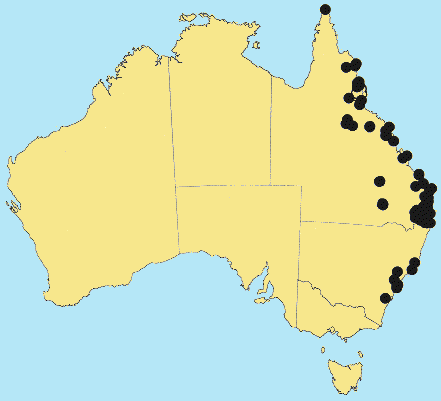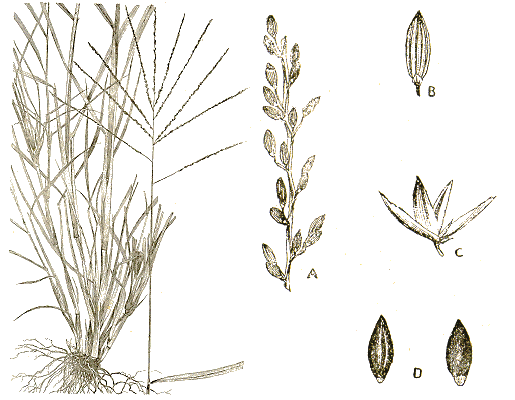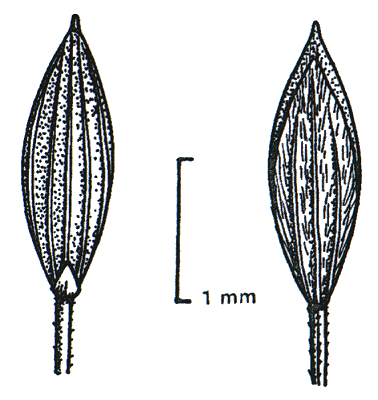Digitaria parviflora (R.Br.) D. K. Hughes. Bull. Misc. Inform. 311 (1923).
Classification. (GPWG 2001) : Subfamily Panicoideae. Paniceae.
Basionym and/or Replacement Name: Panicum parviflorum R. Br., Prodr. 192 (1810).
Type of Basionym or Protologue Information: LT: Brown 6117, Australia: New South Wales: Port Jackson (K (left-hand and right-hand specimens); ILT: BM). LT designated by Henrard, Monogr. Digitaria 523 (1950). (J.) "apud Portum Jackson, inclusis ripis aestuarii Hunter's River vel Coal River.", Note in IGS: "N.S. Wales, Port Jackson, Brown 6116, fide Hughes.".
Key references (books and floras): [1810]. R.Brown, Prodromus (192 as Panicum parviflorum, Panicum striatum), [1878] G.Bentham, Flora Australiensis 7 (470 as Panicum parviflorum), [2002] D.Sharp & B.K.Simon, AusGrass, Grasses of Australia, [2008] S.W.L.Jacobs, R.D.B.Walley & D.J.B.Wheeler, Grasses of New South Wales (219).
Illustrations: [2008] S.W.L.Jacobs, R.D.B.Whalley & D.J.B.Wheeler, Grasses of New South Wales, 4th edn (219).
Habit. Perennial. Rhizomes present, elongated. Stolons absent. Culms erect, 40–90 cm tall, 4–7 -noded. Mid-culm internodes glabrous. Mid-culm nodes glabrous. Lateral branches sparsely branched. Leaf-sheaths antrorsely scabrous, glabrous on surface. Leaf-sheath auricles absent. Ligule an eciliate membrane, 1.5–4 mm long, erose, obtuse or acute. Leaf-blades flat, 3–35 cm long, 3–8 mm wide. Leaf-blade surface scabrous, glabrous or indumented.
Inflorescence. Inflorescence compound, a panicle of racemes. Racemes 4–15, ascending, 6–20 cm long, bearing 50–80 fertile spikelets on each. Central inflorescence axis 2–7 cm long.
Spikelets. Spikelets pedicelled, 2–4 in the cluster. Fertile spikelets 2-flowered, the lower floret barren (rarely male), the upper fertile, comprising 1 basal sterile florets, comprising 1 fertile floret(s), without rachilla extension, elliptic or obovate, dorsally compressed, 1.6–2.1 mm long. Rhachilla internodes brief up to lowest fertile floret.
Glumes. Glumes thinner than fertile lemma. Lower glume ovate, membranous, 0 -nerved. Upper glume elliptic, 1.6–2 mm long, membranous, without keels, 3–5 -nerved. Upper glume surface glabrous or indumented. Florets. Basal sterile florets 1, barren, without significant palea. Lemma of lower sterile floret 100 % of length of spikelet, membranous, 7 -nerved.
Fertile lemma 1.6–2 mm long, without keel. Lodicules present.
Continental Distribution: Australasia.
Australian Distribution: Queensland, New South Wales.
Queensland: Burnett, Cook, Darling Downs, Moreton, North Kennedy, Port Curtis, South Kennedy, Wide Bay, Leichhardt, Mitchell, Maranoa. New South Wales: North Coast, Central Coast, South Coast.
Notes. Closely related to D. diffusa and D. ramularis.
In tropical and subtropical rain forests, tropical and subtropical wet sclerophyll forests, dry sclerophyll forests, and tropical and subtropical sub-humid woodlands. A robust perennial which is common in the shaded forested areas of eastern Australia. Flowers mostly Feb.-July.






